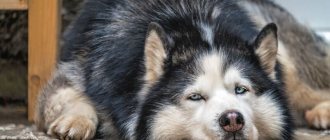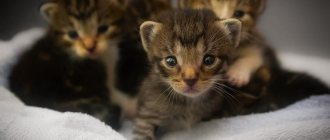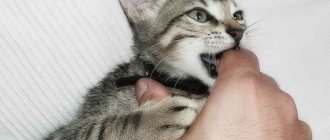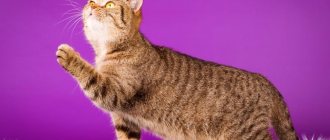Independent and affectionate, smooth-haired and fluffy, large and miniature breeds are being improved, delighting breeders and bringing happiness to the lucky owners of purrs. In February 2022, the international club of cat lovers “Cat Fancier's Association” took into account 42 new breeds that were bred in different countries. How to find green eyes among all the diversity of the cat kingdom?
© shutterstock
Gray cat with green eyes: breed and photo
The green color of the eyes harmonizes perfectly with the smoky gray coat, which was given a more aristocratic name among breeders and felinologists, and the gray color turned into “blue”. It is not at all surprising that the combination of blue fur and magical green eyes became the reason for the formation of several magnificent breeds.
Russian blue
It’s nice that this breed of cat with green eyes has retained Russian roots in its name, although it is not known for certain whether it originates in Russia. These elegant and aristocratic cats with a slender, graceful body, plush fur coat and delicate, gentle character charm people the first time they meet them.
The coat of Russian Blue cats is quite short, thick and dense, evenly colored and has a pleasant pearl-silver tint. Almond-shaped eyes are a bright emerald color as standard; other eye colors are not allowed. We wrote more about the Russian Blue breed in this article.
Nibelung
It is very rare to find cats and cats with green eyes of the Nibelung breed. This beautiful name means “fog” in German. The Nibelungen is a long-haired version of the Russian Blue cat, and they do have a lot in common, such as emerald green eyes and blue fur with silver tipping - the very tip of each hair is bleached, which gives the coat a beautiful silver shimmer.
Basic colors of Scottish Fold cats
The animal may have a gray color, which is obtained by diluting the black color and diluting it with a suppressive gene. Also, white color of animals may occur; it is considered an absence of color due to the suppression of other genes. Cats can be simply white or albino; this occurs due to the action of different genes responsible for establishing color.
The colors come in the following colors:
- Plain black;
- Chocolate;
- Blue;
- Cream;
- Red;
- Cinnamon;
- Lilac;
- Chinchillas;
- Tortoiseshells;
- Tubby and others.
Which cat breeds have specific eye colors?
The color of the iris, like the color of the coat, certain characteristics of the breed (fur length, weight, body shape, etc.) are inherited. Different breeds have their own characteristics, including the shade of the iris. Certain colors are included in the list of characteristics approved by international standards, and if a kitten is born with an atypical eye color, it may be disqualified. What representatives of the cat family look like with different eye shades can be seen in the photo below.
Yellow eyed cats
Burmese Shorthair One of the most common iris colors is yellow.
What breeds are characterized by yellowish, orange, golden eyes? Most often, warm, sunny shades are found in ginger cats, and this color occurs in many breeds. Golden eyes are also combined with a gray, white, brownish, smoky, striped, tricolor coat.
Characteristics of yellow-eyed cat breeds:
| Breed name | Coat color | Characteristic |
| British Shorthair |
| The breed was bred in the 19th century. The body is squat, the head is round, the legs are short and thick. |
| Canadian Sphynx | Hairless cat | Registered in 1966. Lack of fur is caused by mutations. |
| Burma | Chocolate with dark brown areas. | Registered in 1934. Medium size, rounded head, thick and soft fur. The color of the eyes changes depending on the lighting. |
| Somalia |
| Descended from the Abyssinian breed, as a result of mutation the hair became long. The body is elongated, large, but graceful. Well-furred tail, like a fox's. |
| Persian | About 100 varieties of color:
White cats are a separate subspecies of the breed and often have congenital deafness. | One of the oldest long-haired breeds. A distinctive feature is a small and snub nose, a long body. |
| Exotic | About 100 varieties of color. | Bred by crossing Persian cats with American Shorthairs. A characteristic feature is short hair, pronounced stop, cheeks. |
| American Shorthair | More than 80 color and pattern options - from solid to striped. | They were brought to America by settlers from Europe. Large, powerful body. Very calm and affectionate. |
| Scottish lop-eared | Plain:
Striped:
| A distinctive feature is that the ears are curved downwards. |
| Bombay | Black | Miniature "panther" with smooth short hair. |
Professional superstitions
There are a number of signs that exist within the framework of a particular professional activity. This could not have happened without the participation of a black cat.
Remember, you can find black cats in shelters and rescues throughout the county. In fact, rescuers end up with more black cats than any other type of cat. Unfortunately, they are also the last to find homes, according to the Animal Legal Fund.
Rebecca Desfosses is a freelance writer specializing in parenting and family issues. Cats, like other mobs, can breed with other members of the same species. All you have to do is have two tamed cats and make sure they get up. Take two raw fish and feed them one at a time. They will have love hearts over their heads and they will run to each other and have a little chat. Then a small kitten should appear, the pattern of which will match one of the parents.
For example, theater actors have a superstition that if a black cat rubs against the director’s legs before the premiere, then the play will be a great success. In general, the presence of such an animal in the theater is good luck, only if it does not end up on stage. Especially if a cat appears out of nowhere and crosses the stage diagonally, this means failure. But even in this case, you cannot beat the animal - you can try to lure it behind the scenes and be sure to feed it tasty.
Cats can breed once every five minutes, but kittens cannot breed. To tame Ocelots so they can become your Cat, you must feed them 2-5 fish. However, since this is a shy crowd, you will need to stand still. Eventually, Ocelot will slowly approach you, and at some point he will stop and just look at you. Do not make any sudden movements such as moving your head or walking, as the Ocelot will become afraid and run away.
Cats love to sit on chests, beds and active stoves, reflecting the behavior of real cats. While active furnaces are not affected by sitting cats, chests and beds. If a cat is sitting on a chest, it cannot be opened, and if one is sitting on a bed, the player will not be able to sleep. The only ways to stop them from sitting on a chest or bed is to lure them with raw fish, place glass blocks over it, or create a piston device to push them away. Wolves will not attack cats, tamed or otherwise. Due to a bug, cats and dogs can, in rare cases, teleport close to the player for no noticeable reason. This may be intentional to prevent them from getting stuck or unable to follow the player along the same path. Creepers will run away from cats as if they are afraid of them. A standing cat can still breed with a sitting cat, but the kitten will always have the same pattern as a standing cat rather than a sitting cat. If there is a window in the house, the cat may sometimes look out of it. . In Europe, reminiscent of the mini-Panther Bombay, as a true rarity among domestic cats.
Sailors also have characteristic beliefs associated with a black cat. If there is a black cat on the ship, the voyage will go without any problems. But if you throw this animal overboard, an unprecedented storm will break out.
Black cat: signs and superstitions.
The cat's body is narrow, but still muscular. Expressive yellow or green eyes are far apart. Typical of the Bombay are their large and slightly slanted ears, as well as their long, thin legs. Animal fur is smooth and shiny. The history of Bombay was founded by American plant breeder Nikki Horner. Their goal was to breed a domestic cat that was similar in appearance to the black panther and could rival Burmese cats in terms of wisdom and charm. It attempted to reach the breeder through the crossing of the American Shorthair with Burmese cats.
Black cat: signs and superstitions.
Black cat - a talisman for the home
Black cats not only amuse their owners, they also catch mice
Korat
And here is the Korat - another rare and ancient breed: a photo of a gray cat with green eyes will not leave any Thai indifferent. The name itself is consonant with one of the provinces of Thailand, and for good reason. A great many national traditions and beliefs are associated with this cat. According to local residents, korat brings prosperity, wealth and success.
The coat of cats of this breed is thin and not thick, like that of Russian Blues and Nibelungs, but has the same color - silver tipping with a characteristic iridescence. The eyes of a Korat cat are large and round, and the color of the iris is olive green. Other coat and eye colors are not allowed by the standard.
Causes of yellowing eyes in cats
Yellowing of the sclera in a cat is not noticeable due to the large size of the iris. Even an attentive owner notices the icterus in the whites of the animal’s eyes against the background of a general deterioration in the condition of his pet, a change in his appetite or yellowing of the inner surface of the ear or the skin of the pads. Not only the sclera or the lining of the ear turns yellow, the cat’s entire skin changes color, the tongue and all visible mucous membranes become lemon-colored. This condition is called jaundice.
Jaundice, as a symptom, always indicates a high concentration of a substance such as bilirubin in the animal’s blood. It is a derivative product during the normal processing of hemoglobin from red blood cells, which the body needs to transport oxygen to every cell and organ. If hemoglobin is processed at an accelerated pace (under pathological conditions), then soon too much bilirubin will accumulate. Then yellowing of the whites of the eyes and mucous membranes occurs.
In addition to jaundice, your cat will have other signs of illness:
- indigestion;
- flatulence;
- diarrhea or vomiting;
- extreme thirst and excessive urination;
- labored breathing;
- hepatic encephalopathy;
- dark urine and light feces;
- Also, in the last stages of the disease, the animal may experience internal bleeding, and, as a result, blood in the urine and feces.
This condition is far from normal. The animal eats poorly, loses a lot of weight, may suffer from severe pain, and fall into a coma. In the absence of timely medical intervention, the pet may die.
Such a manifestation as jaundice is usually differentiated into parenchymal, mechanical or obstructive and hemolytic forms. Each form is caused by serious pathological processes in the cat’s body:
- Hepatic or parenchymal jaundice is caused by functional and organic diseases of the hepatobiliary system. Hepatitis (inflammation of the liver parenchyma), cholangitis (inflammation of the bile ducts) cause icterus in animal tissues.
- Severe liver diseases: cirrhosis (replacement of the organ parenchyma with connective tissue with loss of its functionality) and cancer lead to yellowness of the skin and mucous membranes. Even excessive accumulation of triglycerides (fats) by liver cells - hepatocytes - leads to yellowness of the sclera and skin.
- Baked obesity, or lipidosis. In this condition, liver cells develop into fat cells. The liver gradually loses its functions, which means the animal may die. Its causes are the cat's excess weight, diabetes, malignant tumors, and hyperthyroidism. Unfortunately, in almost half of the cases the cause of this dangerous disease cannot be established.
- The use of certain medications can lead to changes in the liver and excess bilirubin (bile pigment) in the cat's blood. It is the bile pigment that colors tissues a beautiful yellow color. These medications include: first generation antihistamines (diazolin), NSAIDs (paracetamol), antifungals (griseofulfin).
- Infectious diseases of viral etiology (viral peritonitis), protozoal infections (toxoplasmosis), bacterial pathologies and some parasitic infections cause liver pathology and the release of large amounts of bilirubin into the blood.
- Incorrect use of insectoacaricides (veterinary products intended to combat parasitic insects, in particular ticks). Many insectoacaricides have a strong toxic effect on hepatocytes. Salts of heavy metals also have a similar effect.
- Obstructive jaundice. Obstructive jaundice develops when there is an obstruction to the outflow of bile. Most often it develops due to exacerbation of cholelithiasis (cholelithiasis). If concretions (stones) block the bile duct, the animal develops biliary colic, the temperature may rise, and it is bothered by severe pain in the right hypochondrium. The mucous membranes, sclera and skin turn yellow.
- Inflammatory diseases of the gallbladder and its ducts, their stenosis, pancreatitis, pancreatic cancer can lead to impaired outflow of bile and jaundice. Any tumors of the abdominal cavity that grow into the tissue of the bile ducts or mechanically compress the gallbladder and its ducts can cause large amounts of bilirubin to enter the bloodstream and cause yellowing of the animal’s tissues.
- Hemolytic jaundice. Hemolytic jaundice is caused by hemolysis (destruction) of red blood cells directly in the blood vessels. This happens in some diseases (hemolytic anemia). The cause of hemolysis of erythrocytes may also be severe hypophosphatemia, aggravated by magnesium deficiency. Hemolysis can develop as a result of a cat’s body’s reaction to a blood transfusion. The entry into the blood of hemolytic poisons (zoocoumarin) and medications (warfarin) also leads to the destruction of mature red blood cells.
- Parasitic diseases: feline hemobartonellosis, feline piroplasmosis can lead to hemolysis of hemoglobin. Parasitism of certain helminths that attack vital organs can lead to hemolytic jaundice. This disease in veterinary practice is called dirofilariasis.
Feeding white cats
Of course, it’s nice to pamper your pet with delicious treats, including vitamins, especially considering how many of them can now be seen on the shelves of pet stores.
However, you should not rush to make a choice.
- Danger No. 1 - economy class food. Such foods contain a large percentage of dyes and flavors that make this food as attractive as possible to animals. Alas, these same dyes can have cellular permeability and, if they enter your pet’s body, they can color the tear fluid, and sometimes the fur that grows during the period of feeding these “treats.”
- Danger No. 2 - allergies. Any food can cause allergies, especially in white cats that are susceptible to this scourge.
The consequences are quite obvious: an allergic reaction often leads to allergic conjunctivitis. Conjunctivitis, in turn, causes excessive lacrimation. Excessive lacrimation leads to wetness of the fur of the infraorbital region. Bacteria develop on wet wool, the waste products of which cause a change in hair color.
Danger No. 3 - feed composition. Moreover, this danger does not depend on the class of food.
Food may contain substances that change the color of not only tears, but also the fur itself:
Meat: Some cats experience yellowing of their saliva and tear fluid from beef and chicken dry foods.
Additives: some foods contain ingredients that are beneficial for most, but, alas, undesirable for white cats, such as seaweed, beet pulp, carrots, and liver. Similar components, but in higher concentrations, are often included in treats and vitamins.
This is something to pay attention to. And yet, it is necessary to keep in mind that some white cats will experience darkening, while some will avoid this fate
For lovers of “natural” food, the taboo should extend to liver, carrots and buckwheat.
Fat: Too much fat in the food often causes the coat to become overly greasy. Besides the fact that outwardly this does not make a very pleasant impression, and oily fur can never appear snow-white, there are even less joyful consequences of such feeding.
Firstly, oily wool sticks together and, as a result, more often contributes to the formation of tangles. Secondly, for the same reason, the moisture content of this wool is much higher than normal.
We'll talk about what this leads to a little later. And the most obvious fact: oily wool attracts all the surrounding dirt like a magnet.
What to do?
- Feed your pet only professional food, avoiding economy class products.
- Carefully study the composition of the food, avoiding those varieties that contain “coloring” ingredients.
- When switching to a new food, carefully monitor your pet’s well-being, noting changes in condition, coat color, color of discharge from the eyes, and behavior.
Singapore
According to legend, this rare breed of miniature cats comes from Southeast Asia. Singapura cats have a very unusual coloring - sepia agouti. The ivory body is complemented by dark brown ticking, giving the coat a sandy tint. Singaporeans are characterized by not only yellow, but also yellow-green, as well as bright green eyes. You can learn interesting facts about this breed from our article “Singapore cat and more.”
Khao Mani breed: distinctive features
The snow-white cat from Thailand, called Khao Mani, or diamond eye, has a very ancient pedigree. It is easier to care for such a cat than a Persian, because it is a short-haired breed. This species got its name because of the special cut of the eyes - they are brightly outlined and shine like diamonds.
It is better not to get this cat for those people who are rarely at home, because she does not like loneliness and does not tolerate it well. In character, cats of this species are closest to Siamese.
Interesting facts about black cats
- Charles I adored his black pet and believed that she was his talisman. Surprisingly, the day after the cat's death he was arrested and soon executed.
- Statistics say that there are more coal cats in cities than in villages.
- The best rat catchers are black cats; during night hunting they simply blend into the darkness.
- According to official data from felinologists, twenty-two breeds can have a solid black color; their ancestors are Phoenician cats.
- According to American scientists, most black pets are cats.
- Biologists have proven that any cat creates electromagnetic radiation that has a beneficial effect on humans. The black cat emits waves of high frequency and amplitude; he is the best healer among his brothers.
- Psychics believe that only black pets have the ability to instantly absorb negativity, turn it into positive energy and immediately give it to the owner.
Abyssinian breed and Somalia
These ticked cats also have green or yellow eyes. The main thing, as the standard says, is that their color is intense, without intermediate shades. We wrote more about the characteristics of Abyssinian cats here.
Somalis are long-haired relatives of the Abyssinian cat, so their eye color options are the same as those of the Abyssinian cat.
Cornish Rex
A charcoal coat also adorns representatives of the Cornish Rex breed, emphasizing the extraordinary wavy structure of the coat and giving the cat a special elegance. The breed standard allows any eye color, but the color of the iris must be pure, intense and in harmony with the coat color.
What canned food tastes best for cats?
RESEARCH ATTENTION! You and your cat can take part in it! If you live in Moscow or the Moscow region and are ready to regularly observe how and how much your cat eats, and also remember to write it all down, you will receive FREE SET OF WET FOOD.
Project for 3–4 months. Organizer - Petkorm LLC.
Want to participate? Call!
7
Breeds of chinchilla colors
This group includes all tipped (shell) and shaded (shaded) colors, both silver and gold. All cats with chinchilla coloring have emerald eyes, or an aquamarine and blue-green iris (the exception is cats with red pigment, their eyes are yellow or copper).
The combination of emerald eye color with silver and gold fur looks great, especially considering the expressive eyeliner and nose. This color is found in Persian and exotic cats, as well as in British and Scottish fold cats.
Turkish Angora: characteristics of the breed
There are various breeds of white cats, but perhaps the most famous of them is the Turkish Angora - a harmoniously built, flexible and graceful animal with large, almond-shaped, wide-open eyes, set somewhat obliquely. Originally, this type of cat was only white with blue, orange, green, amber, yellow or different colored eyes.
There are various breeds of white cats, but perhaps the most famous of them is the Turkish Angora. The tail of this beauty is much longer than that of other breeds, resembles a peacock feather and can reach the shoulders.
This breed was formed in Turkey, where it is still highly valued today. Cats with different eyes are especially valued, despite the fact that white Angoras with different-colored eyes are deaf in the ear on the same side as the blue eye.
Black color allowed
American Bobtail
If the previous breed is called the Bombay Black, then among the short-tailed American females there may also be black individuals. This fluffy dog is susceptible to training and has high intelligence. If your pet is accustomed to wearing a harness, he will be happy to take walks with his owner in the park.
The color includes various shades of black and tabby - black stripes on a fawn or gray background.
Siberian cat
These majestic creatures are covered with thick hair with a water-repellent effect, have a double and dense undercoat and “pants” on the hind legs. They are excellent hunters of mice and rats. They are easy to care for and tolerate almost any weather conditions well.
Oriental cat
The elegant blue-black cat with charcoal pads is the most “refined” among its relatives. There are a total of 42 types of colors in individuals of this breed. Affectionate and friendly pets are not pretentious, but they should be protected from the cold.
Devon Rex
Large shining eyes combined with “elven” ears are mesmerizing. The neck is thin and the head is slightly flattened. The beauty walks on high legs and proudly wears her long tail. The animal is energetic and affectionate, and is also well adapted to life in the city.
Turkish Angora
The long-haired cutie was brought from Byzantium. Fluffies can be painted in different colors, including pure black, with white splashes and other options.
Norwegian forest
The fur of representatives of this breed is smooth and thick. Sideburns can be seen on the cheekbones. In winter, a fluffy chic collar “falls” over the shoulders and neck. The ears are pointed with tassels, the tail is long, the legs are high with heavy pads. The color is varied, but always the same color.
Silver tabby cats
Quite often, green eye color can be found in silver tabby cats (British, Scottish, American Shorthair and many other breeds, as well as in ordinary, but no less charismatic yard cats). However, in comparison with chinchillas, it is not nearly as rich and bright. Most likely, breeders, paying great attention to the quality of the color itself, its pattern, have not yet had time to pay due attention to eye color.
Let's make a reservation that silver tabby cats and cats are also characterized by yellow and yellow-green eyes.
Signs associated with ginger cats
Red cats, just like black ones, are haunted by all sorts of legends.
- It is believed that red pets are always obstinate and overly independent. In fact, there is often a very strong emotional connection between an animal and its owner.
- Picking up a ginger kitten on the street and bringing it into the house means attracting prosperity and good luck. Since the fiery color is no more common among street vagabonds than among their purebred relatives, not everyone will experience such happiness.
- Some people believe that a sunny-colored cat absorbs negative energy and protects a person from negative influences.
They also say that they purr louder than others, cure alcoholism, and predict illness and death. The only true observation is expressed in the popular saying “a cat in the house means happiness in it.”
I like4I don't like1
What determines the color of a cat's eyes?
All kittens are born with blue eyes, and only after a few weeks the color of the iris begins to change. What is this connected with? The iris consists of two layers - mesodermal and ectodermal. In the anterior part there are chromatophore cells that contain the pigment melanin, which is responsible for eye color.
The lower the amount of melanin in the iris, the lighter the eye color. There is almost no pigment in blue irises, a little more in green eyes, and cats with golden eyes have the most coloring pigment.
The color of the iris is inherited. Just like coat color, it is associated with a combination of different genes. Inheritance occurs according to a complex pattern, so even experienced breeders cannot accurately predict the color of the eyes of future kittens. Looking at his parents, it is possible to predict the color of the iris in 50–60% of cases.
Heterochromia in the Angora cat
Heterochromia is an unusual phenomenon that occurs not only in cats, but also in humans. In this case, the color of the left and right eyes is different - one of them is blue, and the other may be green or golden. This feature is due to heredity.
Features of white blue-eyed cats
Owners of white cats note their extraordinary modesty and even shyness. Despite their bright appearance, these beauties are absolutely not arrogant or arrogant
They need increased attention and care from their owner. And if strangers often appear in the house, ask them to be as correct as possible and not to frighten your pet - she is suspicious and too vulnerable, and she absolutely does not need unnecessary stress
A white cat can be modest and even timid
Is it true that they are deaf?
The statement that all white blue-eyed cats, without exception, suffer from hearing loss is not true, although such cases are not uncommon. Research by genetic scientists, based on the extensive practice of various breed nurseries, states: a third of these cats do not have any hearing problems. Darwin also noted the connection between the deafness of cats and their white color and blue eyes.
The “culprit” of the deafness of a white cat is the influence of the dominant allele of the W gene, which at the early embryonic stage not only forms the white color of the kitten, but also blocks the growth of cells of the organ of Corti - the peripheral part of the auditory analyzer, its degeneration and becomes the root cause of the animal’s deafness. This is a rare case when one gene forms not one, but several traits - this phenomenon is called pleiotropy.
Even if the kitten can’t hear, he will definitely bring joy to your home.
You shouldn’t refuse to buy a kitten you like just because he can’t hear. But, of course, only if you do not plan to exhibit this animal or use it for breeding. Breeding work with deaf individuals is prohibited in all breeds. And responsible owners should give up the idea of “getting kittens” from their deaf pet. It would be better to spay or neuter such an animal.
You should not keep a deaf cat on a walk, and if you walk with it, do so only on a leash. The risk of getting lost and dying for a deaf cat is very high, and this should always be kept in mind.
Proneness to diseases and other problems
Like all white animals, cats have very sensitive skin. They are prone to allergies and various dermatoses. Overly loving owners who now and then pamper their pet with a variety of “human” treats should remember this feature. Any food from the master's table is a definite taboo for cats in general, and even more so for white cats.
Here’s what you absolutely can’t treat them with “tasty”:
- sweets and fresh pastries;
- peppered, salted and seasoned with any spices;
- smoked, fried and pickled;
- sausage and cheese;
- chocolate;
- citrus fruits.
Sunbathing is not good for a white cat
The delicate skin of a white cat can also suffer from external unfavorable factors - for example, from drafts, frost or, conversely, heat - each breed has its own risk zone. But for all, without exception, “snow whites,” direct sunlight is dangerous. Protect your cat from them - a tan will definitely not be good for her
Severe dermatoses can also be caused by bites of various insects, so it is especially important to promptly treat white cats against all types of parasites.
These animals often have problems with bone tissue, which can cause the development of diseases of the musculoskeletal system and the dental system.
Veterinarian examinations should be regular
What are the differences between albino cats?
White cats with blue eyes are not albinos. Albinism is expressed in the absolute absence of pigment. Such cats not only have white fur, but also red eyes, and the skin under the fur is always painted pink. Blue eye color indicates that there is pigment - it colors the iris of the eye.
Both the eyes and skin of an albino cat are pink.
Albinos have the weakest immunity of all white cats. Drafts, hypothermia or overheating, contact with sick animals and other provoking factors are especially dangerous for them.
In addition, the nervous system of albinos is characterized by increased sensitivity, and this is important to take into account when creating conditions and a comfortable living regime for them.
A comfortable lifestyle is very important for an albino cat.
Breeds of long-haired cats: the beginning of history
There are two versions of the origin of long-haired cats:
- In the cold northern climate, long hair protected from frost and helped animals survive the long winter.
- Representatives of the southern regions acquired a long-haired coat to improve heat exchange - a thick layer of hair prevented the cat’s body from overheating in direct sunlight.
Later, in the 19th century, there was a great migration of cats to the European continent, where interbreeding began.
This is interesting! There are more than 250 cat breeds in the world, a third of them are long-haired animals.
Application
The ancestors of the Russian Blue hunted in the harsh northern climate.
And although today these felines do not have to think about food, they have retained their hunting instinct.
These cats hunt wherever they can. Even in the city, the Russian Blue finds an object of hunting: it catches flies, mosquitoes and butterflies.
She can watch for mice for hours.
The bouncy and curious Russian Blue loves to play. She uses everything she can find to play. These could be toys or different things.
Care and maintenance
Oriental cats do not have an undercoat to protect them from the cold. Therefore, it is advisable to keep them in warm rooms where there are no drafts. Otherwise, caring for them comes down to basic hygiene and periodic washing.
- The Oriental's eyes and ears are regularly wiped with a cotton pad moistened with boiled water or a special product purchased at a pet store.
- The cat's claws wear down on the scratching post. But if necessary, they are carefully shortened with a nail cutter, trying not to injure living tissue.
- Oriental teeth are brushed weekly with a silicone brush and non-foaming paste. This simple procedure will help get rid of plaque and prevent the formation of stone on your cat's incisors and fangs.
- The fur coat of a furry pet is regularly combed with a special brush or rubber mitten. An Oriental Shorthair cat is simply wiped with a piece of clean, damp cloth. Representatives of the breed are bathed no more than 3-4 times a year. This is done using a special shampoo that matches the animal’s coat type.
Interpretations of different dream books
Absolutely all sources believe that dreams with a black cat have meaning and consequences. There are different interpretations, both categorically calling them a bad omen, and those considering such a dream to be a good omen.
The cat signifies troubles from the outside, black magic, the struggle between the dark and light sides of the sleeper’s personality.
Dream book of the 21st century
The animal portends conflict:
- Bitten or scratched - a person from the immediate environment is offended.
- A cat walks across the road - to a meeting with an enemy or a deceiver.
- Petting a black cat means experiencing distrust and emotional distress.
- To catch her is to find out gossip about yourself.
Enigma
Harbinger of negativity:
- The cat dreams of a quarrel or fight.
- If you cross the road, you will meet a woman who wants evil.
- Killing a kitten means missed opportunities, killing an adult cat means triumph over an opponent.
- A dirty and sick animal in a dream means illness of a person from your immediate environment.
- The mating games of “March” cats are the problems of the spouses.
Miller
A black animal in a dream is a negative sign, a symbol of chaos in life:
- If it attacks and tries to bite, the enemies will strive to cause harm, which can be avoided by killing the cat.
- A dirty stray cat means bad news from relatives or a friend’s illness. Meowing - symbolizes lying friends who want evil.
- The cat scratched - the plans of the enemies threaten to come true.
Wangi
A black cat is the personification of selfishness, pride and conflicts:
- Scratched - a person suffers from groundless jealousy.
- If you catch a mouse, you will have to witness a conflict.
- You dream of a huge aggressive cat - a strong enemy seeks to harm.
- Catching an animal means meeting a proud and narcissistic person.
Freud
The cat is a symbol of sensuality:
Feeding him means seeking intimacy with young partners. To caress is to desire sexual intercourse. The animal pets itself - the personality attracts attention. Beating or killing a cat is a tendency towards sadism. If he scratches or bites, the sleeper is prone to masochism.
Health
Russian Blues, like Norwegian Forest Cats and Egyptian Mau, were not bred artificially. They belong to natural breeds.
Therefore, they have strong immunity and good health. They live a long time and very rarely get sick.
Russian Blues are not afraid of drafts and cold temperatures. They do not have any genetic breed diseases.
Although they, like other felines, can suffer from diseases typical of cats.
Vaccinations
For the first eight weeks, kittens are protected by maternal immunity. The kittens are then vaccinated.
Only healthy animals can be vaccinated.
Suitable age is 2.5–3.5 months. For this purpose, combined vaccines against rhinotracheitis, panleukopenia, and calcivirus are used.
Vaccination takes place in several stages. Interval – 3–4 weeks.
Before vaccination, kittens are given anti-worm medications.
Russian Blue is one of the most hassle-free cats to keep.
After a month has passed from the date of the last comprehensive vaccination, kittens are vaccinated, like dogs, against ringworm.
The rabies vaccine is given at 3–4 months of age. It must be repeated annually.
Short tail
It is noteworthy that the presence of a tail in a “rudimentary” state or its complete absence in cats is a sign of “noble” origin (in contrast to the same domestic dogs, whose tails are docked deliberately - to fit the animals to the standards of a particular breed). It is worth noting that there are only a few types of short-tailed/“tailless” cat breeds, which include:
Kurilian Bobtail
a short curved tail approximately 5-9 cm long, resembling a fluffy pom-pom and characterized by mobility, a relatively small body with strong bones, developed muscles and limbs of medium length, a triangle-shaped head with medium-sized eyes corresponding to the color, short-haired or semi-long-haired, but in in any case, with a fluffy collar on the neck and chest.
more details
American Bobtail
a short and flexible tail from 2.5 to 8 cm long (it can be straight, curved, and slightly curled at the end), a body of medium length with an athletic build and strong paws proportional to it, a round muzzle with strong jaws and ears, an internal the surface of which is covered with long fluffy hairs, short or long hair, but always thick and slightly harsh.
more details
Japanese Bobtail
a short tail no more than 12 cm long (straight, curled, curved or in the form of a pompom), a long and lean body with a flat back and slender legs (the hind legs are noticeably longer than the front ones), a muzzle with large oval-shaped eyes and large, wide-set ears, soft and silky coat of medium length.
more details
Mekong Bobtail
a short and broken tail with a length of at least three vertebrae (but no more than a quarter of the length of the body itself), a strong and muscular body of medium size with long legs, a wedge-shaped head with medium-sized ears (with rounded tips) and slightly slanted eyes, always bright blue , short silky coat with minimal undercoat.
Karelian Bobtail
a short tail 4-13 cm long (can be either kinked or almost straight), a strong body with an even posture and proportional paws, a narrow head with a small strong chin and rather large ears with tiny “tassels”, short or long hair ( necessarily dense).
Kurilian Bobtail
“no, not a relative”
short tail 3-8 cm long (with pronounced kinks), strong build with a slightly arched back and powerful paws, large trapezoidal head with a powerful chin and proportional ears, short or long hair (very soft to the touch).
more details
Pixiebob
short straight (but possible kinks) tail about 5 cm long, large and muscular body build with powerful bones and a clearly defined arch on the back, large pear-shaped head, tightly knit and strong paws (the hind legs are noticeably longer than the front ones), short or moderately long hair with different color options, but always with small or medium spots throughout the body.
more details
Manx cat
they may either have no tail completely, or have a small “stump” hidden under the fur, or generally have a tail of normal length, a medium-sized round body with a round head, powerful limbs with well-developed muscles (the front ones are noticeably shorter than the back ones), round eyes with a slight slant, short and thick coat, like “plush”.
more details
Cymric cat
Kymrik
tailless breed (but there can be either a “stump” or even a full tail), a tightly built physique with a wide chest and an arched back, short front and long hind limbs (with heavy shins), thick hair of medium length.
more details











